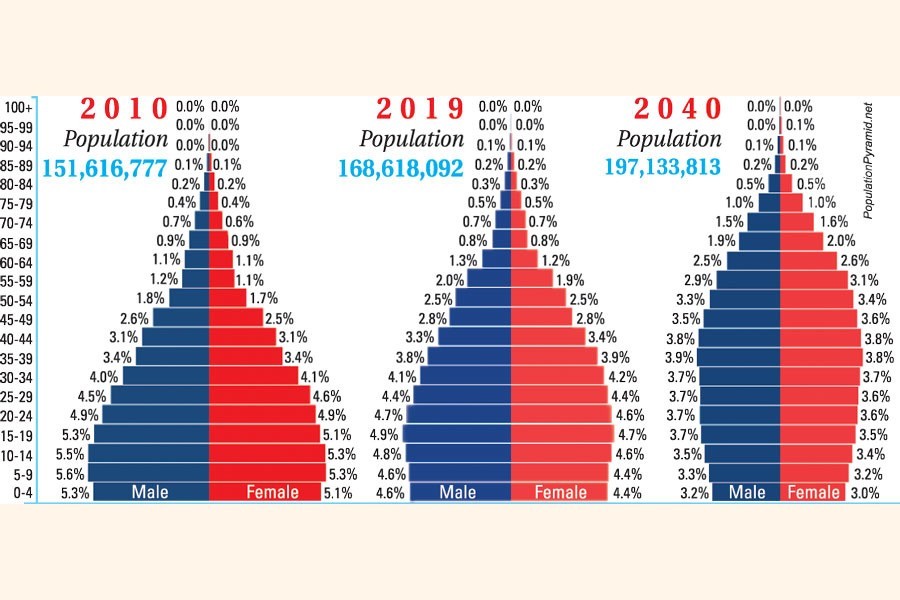Bangladesh could fail to reap benefit from the ongoing most favourable period of its demographic dividend because of inadequate allocations for education and health sectors.
With around two decades remaining until 2040, according to economists and population scientists, the country has failed to step up efforts to enjoy fruits of this demographic boon .
On a frustrating note, the experts said it might miss the boat like another South Asian nation Sri Lanka during its peak period -- 1970-2015 -- for a civil war there.
Demographic dividend is the growth potential that can result from shifts in an age structure, mainly when the share of working-age population is larger than that of non-working-age population.
Bangladesh first reaped the benefits of this 'demographic bonus' in the 1980s and it is now in its third stage, the most ideal stage when mortality and birth rates fall.
The issue is hotly debated as many argue that this boom period will come to an end sometime between 2036 and 2040.
However, the people working on the issue for years said many East-Asian countries exploited this dividend to the maximum possible extent by investing enough resources in education and health care.
They argued that the age structure of a population, particularly working-age population, determines quantity of a labour force while health and education sectors determine quality.
Countries like Japan, South Korea, Singapore and others had prepared their workforce for job markets and built themselves into skilful, energetic manpower through long-term planning and adequate investment to gain this advantage.
"In Bangladesh, allocations to education and health have been falling in terms of their shares in GDP (gross domestic product) over the past one decade," economist Prof Dr Selim Raihan, who has long been studying the same, said.
The allocation for health, in terms of GDP, here fell from 1.1 per cent in 2010 to 0.8 per cent in 2017, revealed a UN Economic and Social Commission for Asia and the Pacific survey.
The allocation is now the lowest among 21 countries of south, southwest and southeast Asia, it disclosed.
The study shows Bangladesh spends only 2.0 per cent of its GDP -- the second-lowest share among the countries surveyed -- on education.
In contrast, Bhutan, the Maldives and Nepal all spend nearly 5.0 per cent of their GDP on education.
"To my mind, policy-makers are not interested in it. They possibly think this is natural and everything will happen naturally," he told the FE.
Dr Zahid Hussain, lead economist at the World Bank's Dhaka office, said those who will take the economy forward -- the educated youth -- are now mostly unemployed.
"This is a most frustrating matter…," he told the FE.
Dr Hussain said labour demand is huge but youths do not find jobs as their education does not match with job requirements.
According to the latest labour force survey conducted by the Bangladesh Bureau of Statistics (BBS), the country has now over 2.7 million unemployed people, equivalent to the total population of Rome.
The survey, done by the BBS, showed the country has a 63.4-million labour force.
On the other hand, another important issue raised by Dr Hussain is about low labour force participation. "Especially, female labour force participation remained stagnant at around 36 per cent."
He said the 'skill mismatch' issue should be addressed to tap the benefits of age structure of the population, "otherwise, the dividend will remain as a potential."
Dr Hossain Zillur Rahman, executive chairman at Power and Participation Research Centre, said a significant chunk of population remains in the NEET (Not in Education, Employment or Training) category.
"How will we utilise it?" he questioned.
Meanwhile, population scientists say the government is not 'proactive' on the issue despite the fact that 64 per cent working-age population now exists.
No meeting has been held in the past one decade of the national population council that looks after demographic challenges and prospects, they argued.
The scientists observed that there are many objectives in the national population policy, but most of them like total fertility rate have remained unmet for long.
The government prepared the population policy in 2012.
Prof Dr Md Moinul Islam, who teaches population science at Dhaka University, told the FE that the government is not taking the issue seriously.
"There is no meeting held over the past one decade of the national population council," he said.
Demographic dividend is a natural phenomenon but does not provide benefits automatically, said Dr Islam who has been working on the issue for long.
Dropout is huge at primary and subsequent levels, but there are no effective measures to stem it, he continued.
"We need proper education, healthy labour force, good investment and good governance for exploiting the dividend," Dr Islam said.
However, people at different ministries told the FE that the government has taken multiple measures to harness this dividend.
The measures include National Skill Development Authority (NSDA), National Human Resources Development Fund and strengthening public training institutions.
Skills for employment investment programme (SEIP), a project under finance ministry, has been working with industry people and institutions to raise efficiency of the working people.
"The NSDA's organogram has already been completed. It will work soon," SEIP consultant Md Khairul Islam told the FE.
He said two industrial skill councils have already been strengthened-one for construction sector and the other for light engineering sector.


